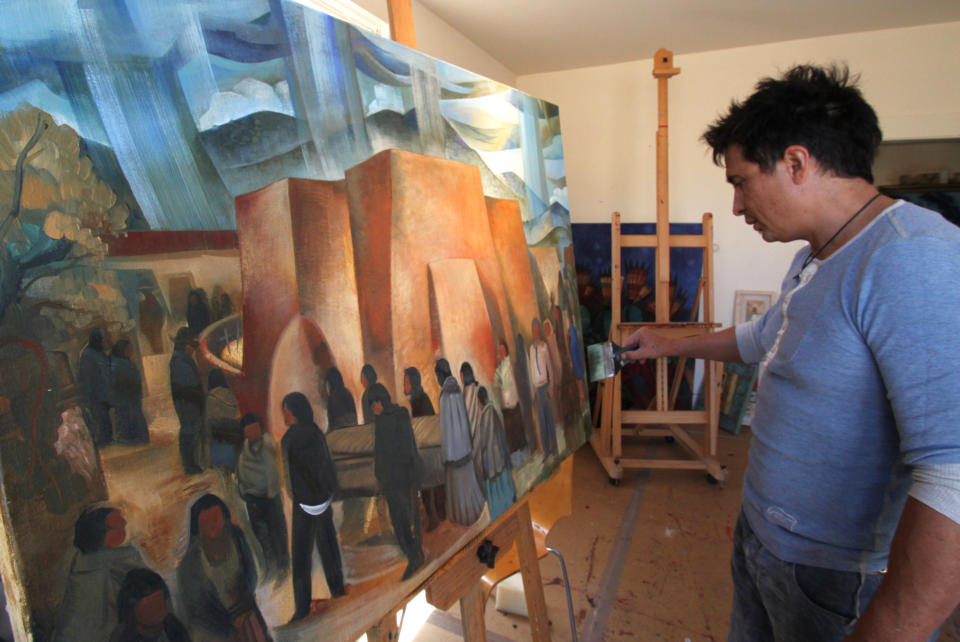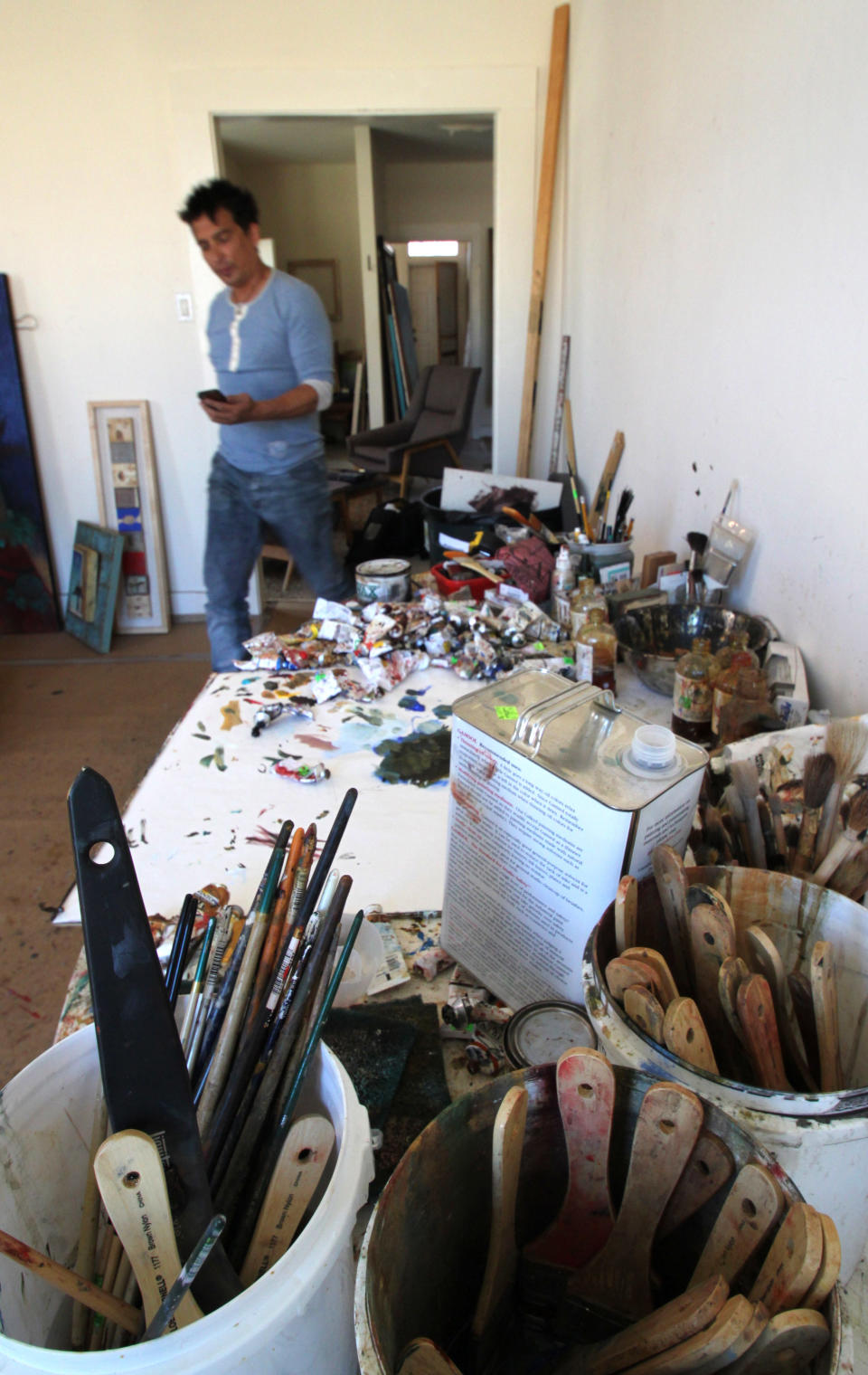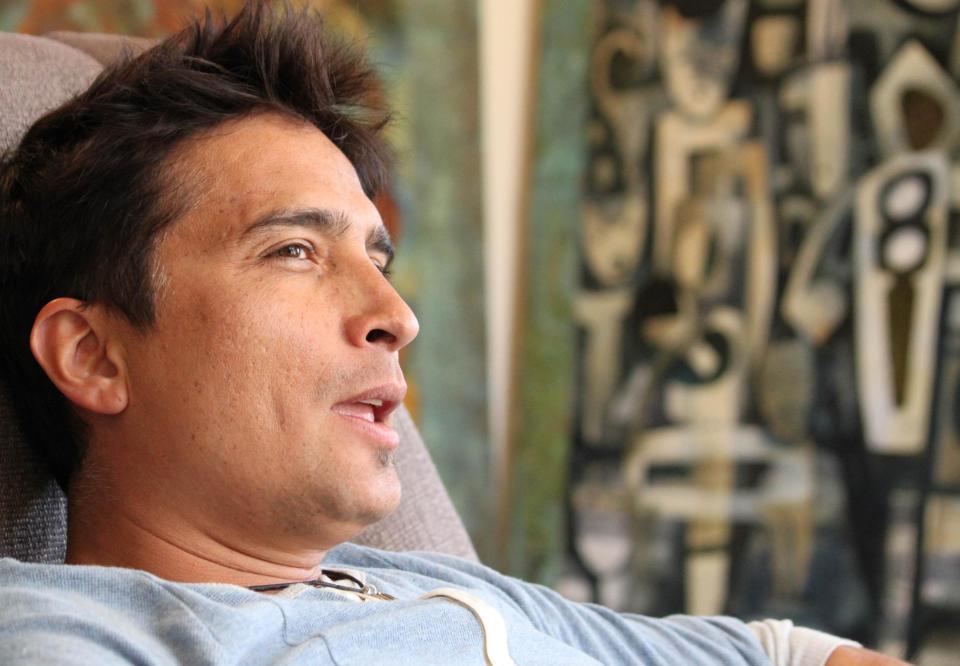Santa Fe festival will honor Navajo artist
SANTA FE, N.M. (AP) — Artist Tony Abeyta just can't help himself.
Pushing up his sleeves and letting his fingers make one more run through his deliberately tousled hair, he reaches for a bit of charcoal on his studio table and goes at the three finished canvases again.
In minutes, his fingertips are black, his forearms are smudged and there's one more layer on the triptych he has dubbed "Divine Intervention." Just in time for the curators to pick it up.
The work will be hanging in the entry of the Museum of Indian Arts and Culture as part of the annual Native Treasures Indian Arts Festival, which opens in Santa Fe on May 25 with Abeyta being recognized as this year's "living treasure."
"I feel fortunate," the Navajo painter and jewelry designer says. "I have an immense amount of gratitude that I can do what I do. I basically come in here and do what I want. I don't have to be influenced by the market place, by my gallery, by collectors. I like the idea that I can be the music maker in the studio here."
Abeyta says it's a little strange to think of himself as a living treasure at age 46. But festival organizers say the reasons were clear: his style, his time spent mentoring other young Native American artists and his refusal to fall back on formulas when it comes to creating art.
Abeyta is among the artists who are pushing the envelope when it comes to redefining American Indian art.
Curators, gallery owners and collectors say the stereotypical images of horses and Indians clad in feathers have given way to more contemporary work that stems from spiritual sensibilities often rooted in nature, tradition and culture.
"As a Native American and as a Native American artist, the spiritual is part of who I am and what I do. And I work at that," Abeyta said. "When I'm painting and I'm right on, I'm channeling all of this stuff from some other place, from some divine. I don't know what it is."
More than 200 native artists from over 40 different tribes have been invited to the two-day festival, which marks the start of Santa Fe's summer art season. Everything from pottery and jewelry to carvings and textiles will be on display.
The show has grown over the last seven years, but its mission to raise money for the Museum of Indian Arts and Culture remains the same. The museum receives state funds for operating expenses, but money for staging exhibitions must come from private sources. The festival takes place at the Santa Fe Convention Center though some works will be on display at the museum.
Organizers spend months scouting for artists to invite to the festival. They look for those who are established like Abeyta as well as emerging artists. The range of work stretches from the more traditional to modern abstraction.
"I think there's a real appreciation for the traditional work and I think it's great that artists are still keeping those traditions alive, but there's a real acceptance of things that are nontraditional," said Ardith Eicher, one of the show's co-chairs. "Some of the contemporary work that these artists are doing is amazing."
So what does it take to be a living treasure? One of the criteria is innovation, Eicher said.
Abeyta fits that bill. Aside from having his work in museums and private collections across the country, his accomplishments include a painting that served as the official illustration for the opening of the Smithsonian's National Museum of the American Indian in Washington D.C.
The gathering space at the Museum of Indian Arts and Culture in Santa Fe also features one of his murals.
At the Blue Rain Gallery in Santa Fe, director Peter Stoessel pointed to three very different pieces by Abeyta: a landscape made of large, angled brush strokes, a charcoal drawing of biomorphic shapes and a collection of panels featuring baseballs, birds and butterflies.
"He's a phenomenal artist and yes, he's Navajo and that imagery will pop up in his paintings, but at the end of the day, he's an artist who happens to be Native American," Stoessel said.
Back at Abeyta's second-floor studio just off the Santa Fe Plaza, the artist continues to juggle time between an interview and the curators who are there to collect his charcoal triptych.
"These things are very intuitive," he says of the amoeba-like shapes. "They're coming from some inspired place."
Abeyta's inspiration comes from nature. He's always looking at colors, cloud formations, angles and what he describes as a rhythm between the mesas and mountains. If he sees something, he'll take a snapshot and file it away for later.
"My small universe is really about nature. It's about light, it's about ... design," he said. "When I'm on it, I can just keep working and it's almost musical. It's the shapes, the forms and the directions that they all sort of carry my eye."
The son of a painter, Abeyta grew up in Gallup, N.M., on the edge of the Navajo Nation. At 16, he left to pursue his education at the Institute of American Indian Art. He later studied at the School of the Art Institute of Chicago and at New York University.
Three decades later, he has become a bit of a hipster and his teenage daughter and 21-year-old son appear to be following in his footsteps. His son is a film student and his daughter is into contemporary art.
Abeyta says it's as if the creative muse is channeled from one generation to the next. The inspiration may be inherent, but he says the creativity can evolve much like Indian art has from the early days of utilitarian cookware and painted hides.
"Some artists use words like 'breaking all the rules.' I don't think it's about breaking the rules," he says. "I think it's just continuing in a creative direction. Art just constantly changes and evolves."
___
If You Go...
NATIVE TREASURES INDIAN ARTS FESTIVAL: May 26-27 festival at the Santa Fe Convention Center, 201 W. Marcy St., Saturday $10-$20, Sunday free. May 25 benefit, 5:30 - 7:30 p.m., at the Convention Center, $100; http://nativetreasures.org/.
___
Follow Susan Montoya Bryan on Twitter: http://www.twitter.com/susanmbryanNM








